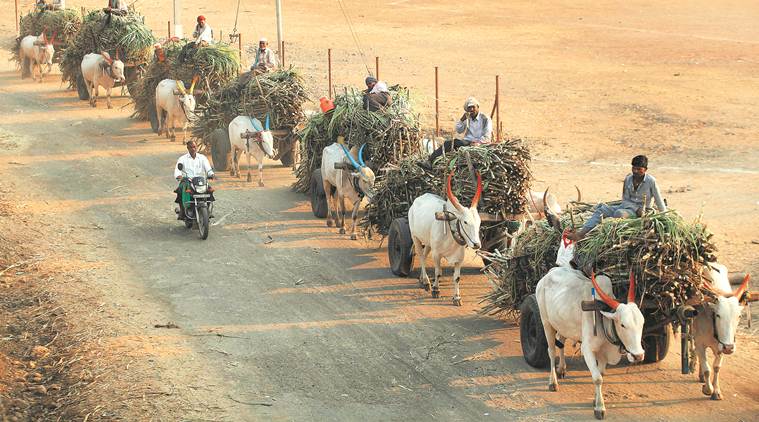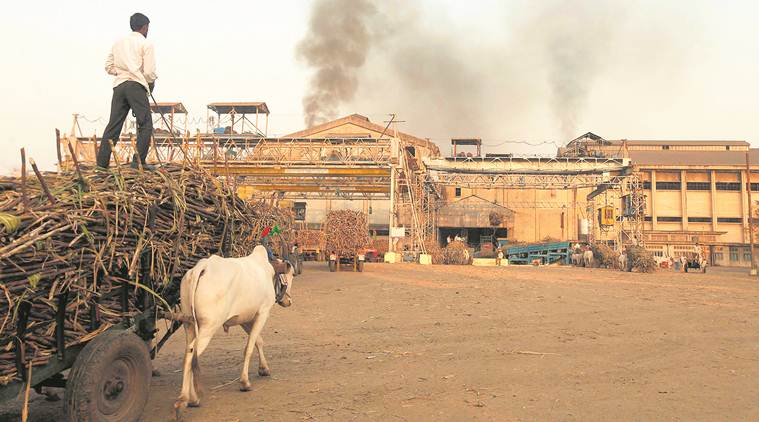
THE FARMER
On most mornings like today Sajjan Mane, 29, is at his field in Karad taluka in Maharashtra’s Satara district. But these days he is busy working out whether to travel to Pune on January 28 for a farmer march called by the Swabhimani Shetkari Sanghatana to the office of the Sugar Commissioner.
Squatting amidst bags of cattle feed, at the clinic-cum-shop run by local veterinarian Dr Krishna Madane, Mane and other farmers weigh the benefits of travelling the 165 km to Pune. Mane has brought along his bank passbook to highlight his frustration: “In November I sold 550 quintals of sugarcane from my 1 acre land to two cooperative mills, Sahyadri and Yashwantrao Mohit Krishna. I hoped to receive Rs 1.5 lakh. My earnings were just Rs 93,000.”
Worrying signs for government
Between January 11 and 14, the anger over pending sugarcane dues among farmers such as Mane across the districts of Satara, Sangli, Kolhapur and parts of Solapur spilled onto the streets, with field offices of around 10 mills burnt. Ten days later, the remains of the offices stand witness to that anger. The protest was called off after millers promised to stop making partial payments. Through the row, the state government remained conspicuous by its silence.
Mane has to pay a Rs 14 lakh loan he took last year to set up a poultry unit. “But all my earnings from the cane I sold in November were used by banks to settle the Rs 95,000 loan I took.” He is now worried about the cane growing on his remaining 3 acres in village Babarmachi in Karad, which will be ready for sale by March.
Nestled between the Krishna river and the Pune-Bengaluru highway, mills in Karad had escaped arson, but farmers had locked down field offices of several of them.
Sugarcane has long driven the economy in these parts, with farmers devoting almost 80 per cent of their holdings to it despite cane taking longer (12-18 months) and costing more to grow than, say, wheat or soyaben. Karad’s well-lit roads and bustling shopping centres, comparable to cities like Pune in infrastructure and access to quality education, are a testimony to the prosperity driven by the crop. Western Maharashtra accounts for 98 of the 189 mills in the state and 60 per cent of its sugar production.
In better times, these mills are known to be better paymasters than others across the state, making timely payments as well payments higher than the government-declared FRP (Fair and Remunerative Price). Mills are willing to offer more because cane of this region is known to yield more sugar per tonne (recovery of 12 per cent, compared to the state average of 11.24 per cent).
However, this year, the state mills have paid only Rs 2,875.36 crore of the Rs 7,450.89 crore due to growers. Most mills are offering just Rs 2,300-2,400 per tonne, which is 80 per cent of the average FRP of Rs 2,800. The glut in production has dimmed any chances of better realisation. Maharashtra ended last season with 107 lakh tonnes of sugar, an all-time high. The opening stock for Maharashtra this year was around 40 lakh tonnes, with the state slated to produce around 100 lakh tonnes this season.
Prasad Dhokate, 27, who owns 10 acres in Virwade village, is yet to receive any payment, locally called uchal, for 600 quintals of cane. Tallying his costs, Dhokate says he spends Rs 40,000-45,000 per acre, which is up these days by Rs 10,000 due to higher fertiliser prices. Rising farm labour costs, from Rs 200 per day to Rs 250, have added to the expenses. “Have our incomes increased commensurately?” he asks, pointing to his home that needs repairs.
With around Rs 3 lakh of unpaid dues, Dhokate breaks into cold sweat over tales of partial payment of FRP. “How are we to pay our liabilities at such ridiculous rates?” he asks.
Both Mane and Dhokate are unmarried, unusual for men in their late 20s for this Maratha-dominated area. Jaisingh Jadhav, 67, says fathers of girls don’t want them to marry farmers. “Cane farmers who were insulated from vagaries of prices have also become like other farmers now.”
THE MILL
Apart from driving the economy, sugarcane here has also spawned political careers. Almost all the leaders in the region are associated with the sugar sector, with most mills owned by Congress or NCP leaders. Swabhimani Shetkari Sanghatana leader Raju Shetti is an MP from Hatkanangale constituency in Kolhapur district.

Sitting in his well-lit office in Karad, Balasaheb Patil, the NCP MLA from Karad North and the chairman of Sahyadri Cooperative Sugar Mill, says it is the first time the mill is paying FRP in instalments. Set up in 1969, the mill is spread over 350 acres. With a capacity to crush 7,500 tonnes of cane per day, it counts over 164 villages in its area of operation. “This year we will crush 23 lakh tonnes of cane,” Patil mentions proudly. “Last season we had paid Rs 200 more than the FRP.”
Sahyadri, in fact, Patil says, is the best when it comes to payments across the state, adding that it is the farmers’ trust in them that has kept them going. “When a group of protesters came to lock our field office on January 12, the others prevented them.”
The complex economics of the sector involves mills like Sahyadri availing loans from banks at the start of the crushing season, by pledging their sugar stock. Banks issue loans setting a particular ‘value’ to the sugar stock, which at present is Rs 3,000 per quintal (Rs 30 per kg). Eighty-five per cent of the valuation — Rs 2,550 per quintal — is made available to mills by the banks, but the mills use 15 per cent of it for their operational expenditure like paying salaries, buying gunny bags etc. That leaves them with Rs 2,100 to pay the growers, while the average FRP is around Rs 2,800 per tonne.
Since January 2018, sugar prices have dropped despite government efforts. In the range of Rs 3,500-3,600 per quintal (Rs 35-36 per kg) at the start of the 2017-18 crushing season (September-October), prices had dipped to Rs 24-25 per kg by April-May. On June 6, 2018, the Centre fixed the minimum ex-mill selling price at Rs 29 per kg.
Patil, who says it costs them Rs 34 per kg to produce sugar, says this comes on top of subdued international prices, rendering the government subsidies to promote exports ineffective. He says the sugar industry has made several representations to the Centre and state government for help, including seeking a Rs 500 per tonne bailout for farmers or raising the minimum selling price of sugar to Rs 34 per kg. “We are yet to see any positive step.”
While he acknowledges that falling sugar prices have tied the hands of mill owners too, Dhokate argues why farmers can’t afford to climb down. “If we allow the mills to pay in instalments, it is likely to become a permanent feature,” he says.
Sugar Commissioner of Maharashtra Shekar Gaikwad has warned mills to pay up the FRP or cough up interest at the rate of 14 per cent for late payment. “Small land holders who sell less than 50 tonnes of cane should be paid 100 per cent of the FRP at one go,” he said in a letter.
One unlikely victim in all this is Dr Madane, the local veterinarian-cum-supplier of animal feed and medicines for villages in and around Babarmachi. Over the past year, he says, his unpaid fees have crossed Rs 3 lakh. “This is the first time farmers have defaulted. Now I am being pressed by creditors to clear my dues.”